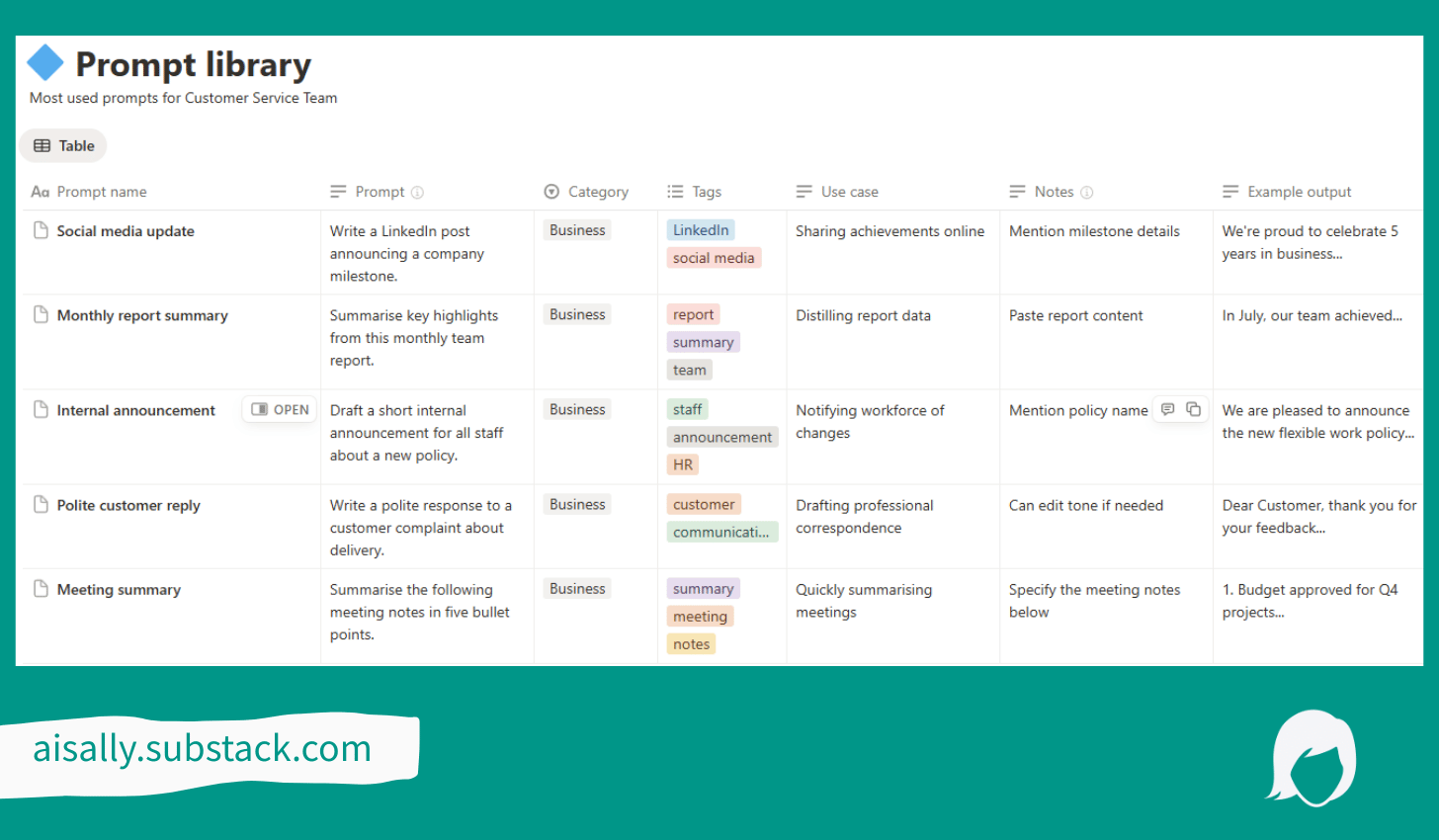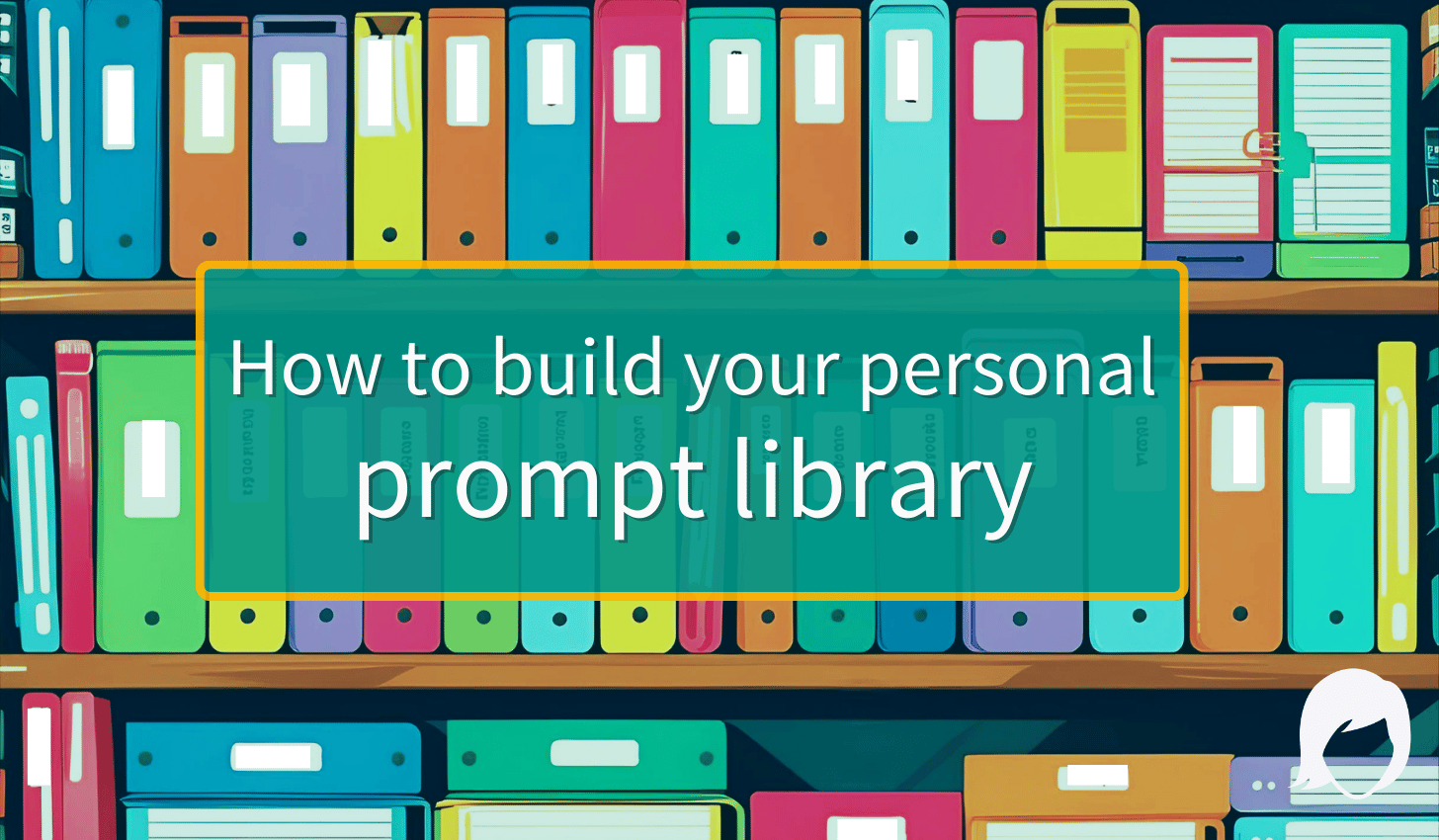How to build your personal prompt library
Organise your best AI prompts into a simple, reusable system that saves time and sparks creativity.
When I first heard the term “prompt library,” I felt intimidated. It sounded technical, daunting, and maybe even a little unnecessary—like something only IT specialists or coders would need. Honestly, I didn’t know where to begin, or if it would even be worth it.
But after doing some research and seeing how other professionals organise their best prompts, I gained enough confidence to try. Now I manage my prompt library in Notion, constantly adding new ideas and refining old ones. It’s become an essential part of my digital workflow—and far less scary than it first seemed.
What is a prompt library (and why every AI user needs one)?
A prompt library is simply an organised collection of your most effective prompts—the questions, instructions, and templates you use with AI tools like ChatGPT.
Think of it as your “ready-to-go” kit for working smarter:
Consistency: Get predictable, repeatable results with prompts that already work.
Speed: Copy, paste, or adapt instead of starting from scratch.
Quality: Improve results by refining prompts over time.
Creativity: Use your library as a springboard for problem-solving and new ideas.
👉 Related: In my article on why training your AI assistant matters, I explained how refining prompts improves results. A library takes this one step further by keeping your best work at your fingertips.
What makes a good prompt?
A prompt is anything you ask your AI, such as “Summarise these meeting notes for my team” or “Draft a friendly reminder email for patients.”
A strong prompt is:
Clear about what you want and any important details.
Contextual, giving background like who the audience is and what the goal should be.
Actionable, with verbs like “list,” “summarise,” “explain,” or “rewrite.”
Flexible enough to adapt for similar tasks as your needs evolve.
Compare these two examples:
❌ Poor: “Tell me about diabetes.”
✅ Better: “Explain type 2 diabetes in simple language for high school students. Use bullet points and a real-life example.
Step-by-step guide: how to build your AI prompt library
1. Reflect on your routine tasks
Think about your daily work—emails, reports, lesson plans, patient communications, creative brainstorming. Where do you already use AI, or wish it could help more?
2. Collect and test prompts
Write down the prompts you often use or try new variations to see what works best. Keep the ones that consistently produce helpful results.
3. Identify categories
Group prompts into themes that make sense for your work. Examples include Communication, Research, Brainstorming, Data Analysis, Customer Service, Creative Writing, Education, Healthcare, and Reporting.
4. Choose your format
Pick a tool that suits your style:
A digital notebook like Notion, Evernote, or OneNote if you want flexibility and tagging.
A spreadsheet such as Google Sheets or Excel if you prefer filters, sorting, and search.
A document or folder system (Google Docs, Word, or cloud folders) if you just want quick access or a running list.
A dedicated prompt manager app if you’d like something more purpose-built.
5. Develop a simple structure
For each prompt, capture a few key details. This could include:
The category or purpose (e.g. “Brainstorming”, “Email replies”, “Lesson planning”).
The exact prompt text in clear language.
A short note on how you’ll use it (“Use for client reminders; add payment deadline for clarity”).
Optional: a sample high-quality response to remind you of what a “good” output looks like.
Here’s a simple layout you could use:

What to include in your AI prompt library
Start with the basics and let it grow:
Core templates: everyday tasks like emails, summaries, meeting notes, or project updates.
Profession-specific prompts: lesson plans for teachers, patient instructions for health workers, brainstorm ideas for creatives, customer service replies for businesses.
Tone and voice options: prompts that shift your style between formal, friendly, concise, or playful.
Scenario starters: for tricky challenges like time management or conflict resolution.
Experimentation prompts: ideas you’d like to test in the future.
Over time, jot down quick notes about which ones work well and which need adjusting. That way, your library naturally improves alongside your workflow.
👉 Related: In my article on advanced AI prompting techniques, I shared 8 methods to improve results. A prompt library is the perfect place to store and test those techniques.
Refining, sharing, and collaborating
A prompt library isn’t something you set up once and forget. It becomes much more useful when you review and improve it regularly. As you use prompts, tweak the wording for better results and note any clarifications that help.
If you’re part of a team, consider setting up a shared library in Notion, Google Docs, or Trello. This way, colleagues can contribute their best prompts, and everyone benefits from a collective resource that saves time and spreads good practice.
How to maintain and update your prompt library
Think of your library as a living resource. Set aside time every month or quarter to review it. Remove prompts that no longer fit, revise those that could work better, and add new ones as your role evolves or you discover new uses for AI.
You’ll also find value in keeping an eye on community spaces—forums, newsletters, or professional groups. These often surface creative prompt ideas you can adapt and bring into your own collection.
Bonus resource for subscribers
Want a head start? As an AI Sally subscriber, you’ll get exclusive access to a downloadable prompt starter pack—a collection of ready-to-use prompts for business, education, healthcare, and creative work.
Already a subscriber? Don’t worry—you’ll find the download link in your inbox, and I’ll include a reminder in an upcoming newsletter so you don’t miss out.
It’s a fast track to building your own library, helping you save time, spark ideas, and get more consistent results right away.
Final thoughts
Prompt libraries help you get the most from AI tools, turning everyday tasks into smoother, faster, and often more creative workflows. Start with a few simple prompts, organise them in a way that fits your style, and keep refining as you go. Whether you’re working solo or in a team, a thoughtful prompt library is one of the smartest habits you can build—it not only makes AI easier to use but also boosts your confidence and efficiency along the way.
If you missed earlier articles about how to write prompts, you might also like my other articles:



